Better Dancer: How To Learn Choreography, Part 2
This is the second of a three part series on tips, tools and advice on improving your ability to learn choreography. The first part covered preparation, this part will cover tips and advice on learning in class, and the last part will cover recall and refinement of choreography.
Learn
Depending upon the level of the material and the teacher, choreography is presented and taught in a variety of ways. Whether the instruction is purely visual repetition, sequencing, or count by count; these tips helps.
Create a Blueprint
As the choreography is demonstrated, create a mental outline from what you see and hear. Mark significant changes, shifts and movements in your mind.

Having an outline or birds eye view of the overall structure of the choreography is like having the blueprints to a building. You’ve got the plan, now you have to become the construction worker – starting from the foundation to the frame to the sheathing, walls and so on until it is complete.
Break It Down, Build It Up
Choreography is in essence a sequence of movements, long or short. Experienced dancers can understand and recall large chunks of sequence quickly, while less experienced dancers understand more basic chunks.
Just like building with legos, you need to put the pieces together one by one to form each chunk and then assemble the chunks into a larger whole.
Know your chunk size.

By that, know how long or short of a sequence you can address and repeat quickly. As the choreography is taught or shown, begin with chunk sizes you can process easily (whether that is 8 counts of movement or a full phrase of music).
Start at this level and begin combining them into larger chunks.
Work on creating several larger chunks individually, then assemble the larger chunks into the even larger chunks until you have assembled the whole choreography.
Use Cues to Anchor Chunks
Develop verbal, spatial and musical cues to anchor chunks of movement to specific times, places, and rhythms.
Cues come in many forms.
Spatial cues anchor what comes next with where you are at a certain point in space. This can be placement within a group of dancers, location on a stage, or body position. By tying a chunk to spatial cues you take the pressure off of recalling larger chunks by placing chunks into context.
Verbal cues anchor what you are doing with a verbal phrase or series of sounds. They can be as simple as verbal rhythms spoken while performing the physical representation of the sound, or as deep as stories representing various movements or sections of the dance that carry one section into the next.
Musical cues anchor what you are doing and what comes next with the music being played for a piece. While not all choreographies are performed to music, many are. Knowing that a specific chunk follows a particular hit in the music, or a shift in the mood of the music changes the style of the momvent, allows you to place chunks into context.
Cues place content (the chunks of movement) with context. By understanding context we can deliver content adeptly.
 Do It, Don’t Watch Yourself Do It
Do It, Don’t Watch Yourself Do It
If your studio has mirrors, don’t focus on what you are doing as you dance it in the mirror. Focus on the experience of performing the movements correctly. The mirror is a refinement tool, not a framing tool.
Placing too much emphasis on a mirror distracts you from engaging your bodies memory. Save the mirror for refinement – or even better, use a video camera to review your performance.
In Your Words
Whether you are using a physical dance journal, or a digital dance journal, capture each step of your learning process so you can use it to recall, reflect and refine your performance of the choreography in the future.
This note taking process puts the choreography into your own words.
Focus
When in the studio learning choreography put the rest of the world out of your mind. To learn swiftly you need intensity of focus.
Watch the lead dancer or instructor demonstrate first, don’t attempt to mimic immediately. Watch the whole presentation of the choreography, take note of the outline, the chunks, the cues. Create the outline, listen and watch for the cues, and fill in the outline with the pieces.
Focus ties all of the elements together.